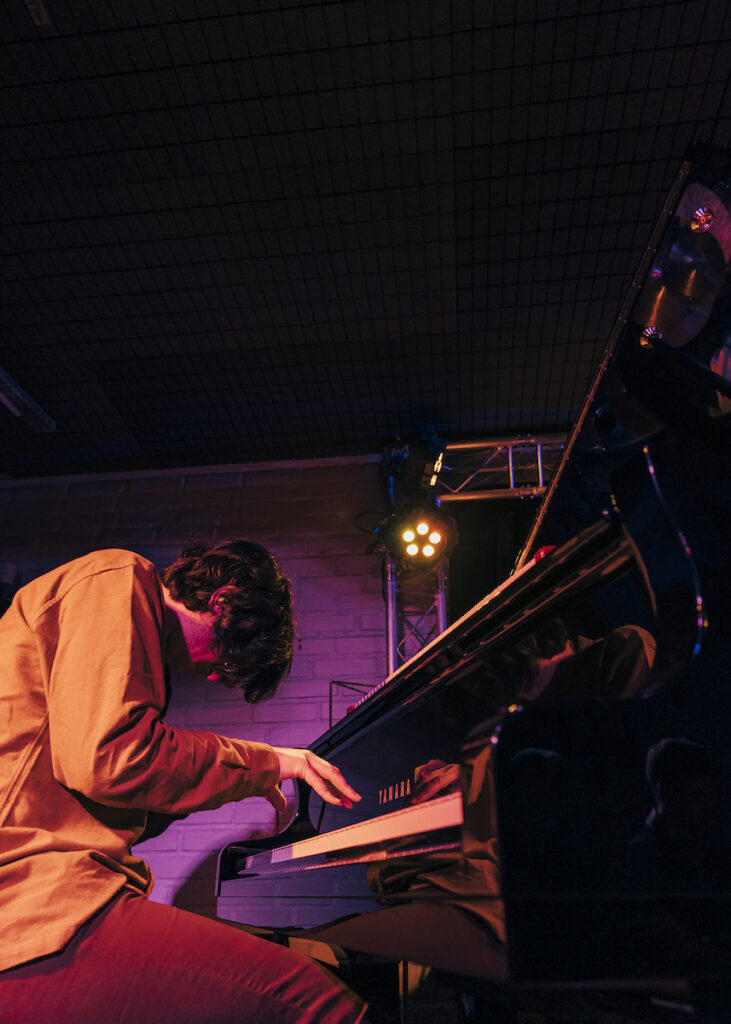
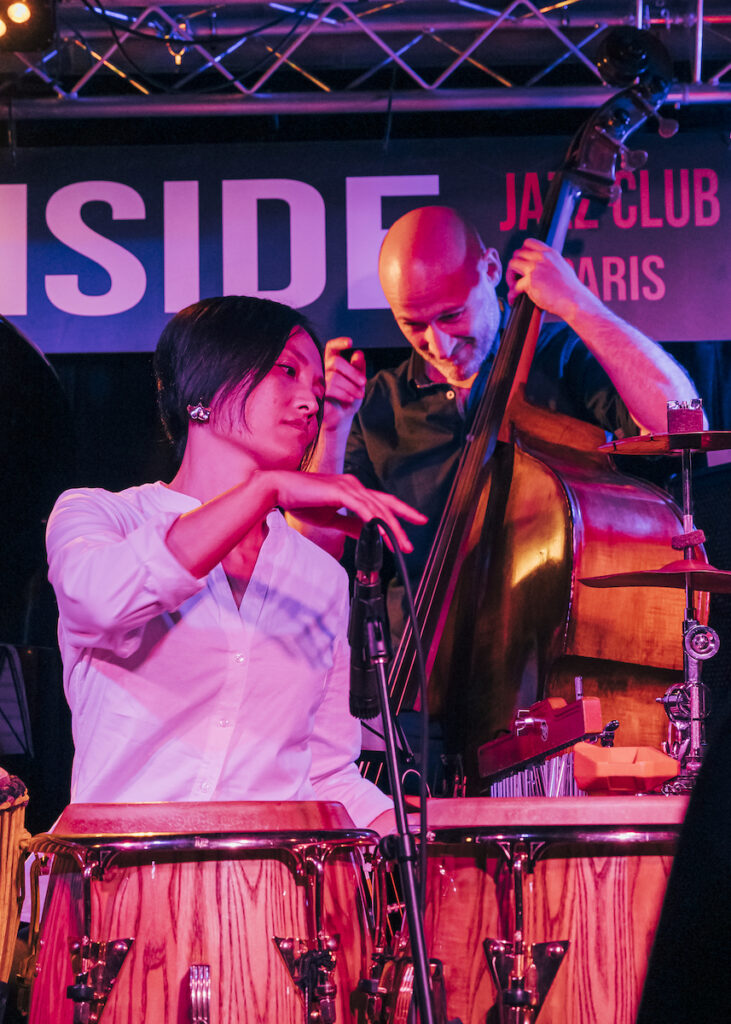
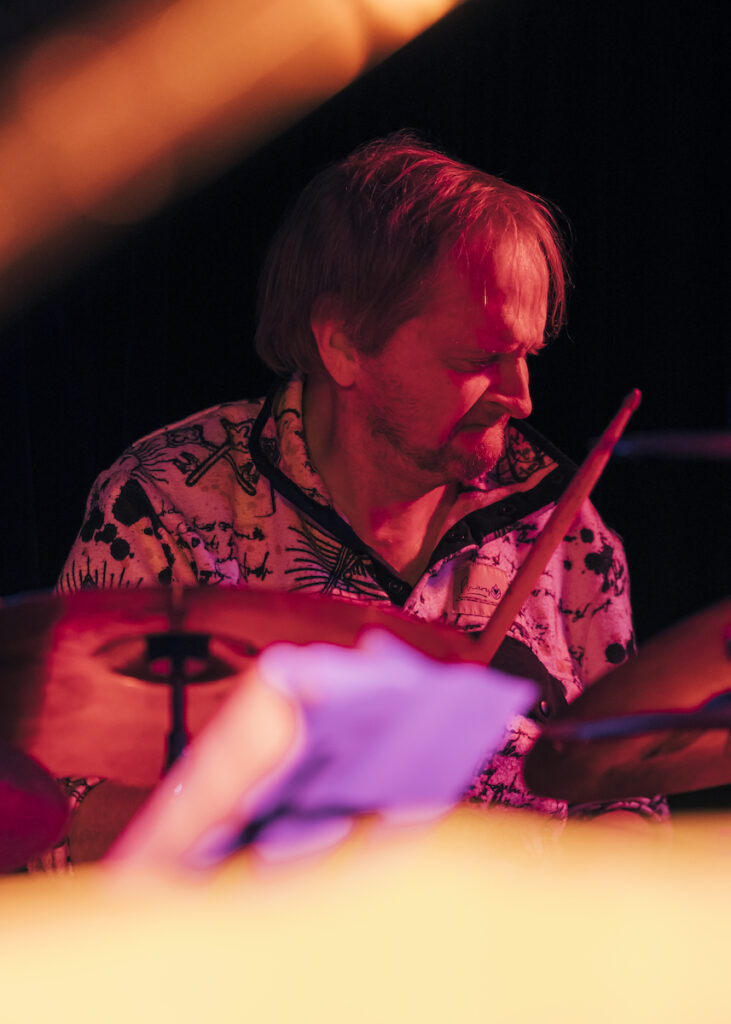
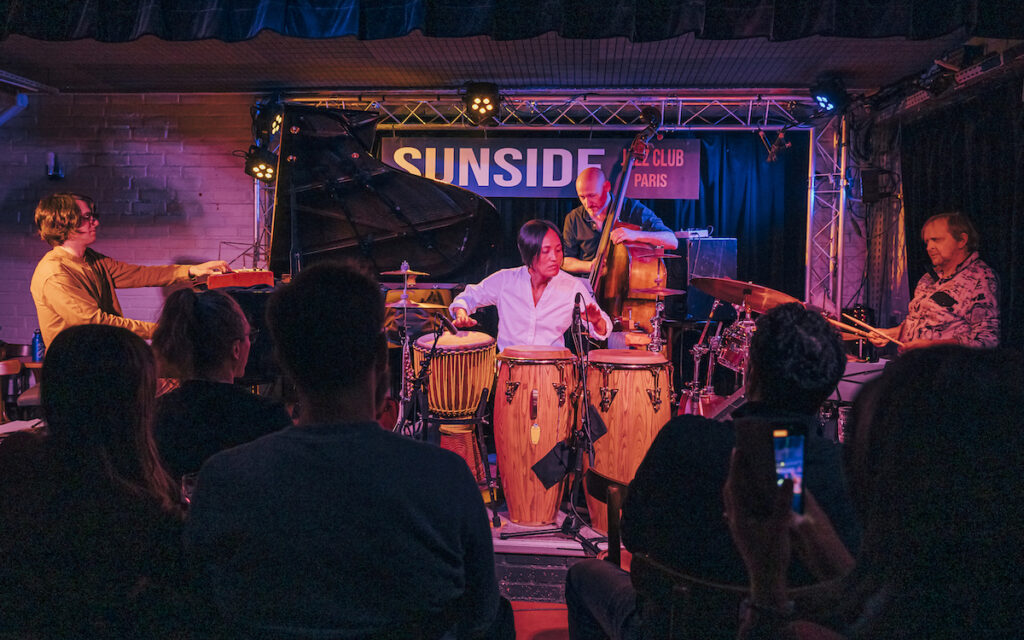

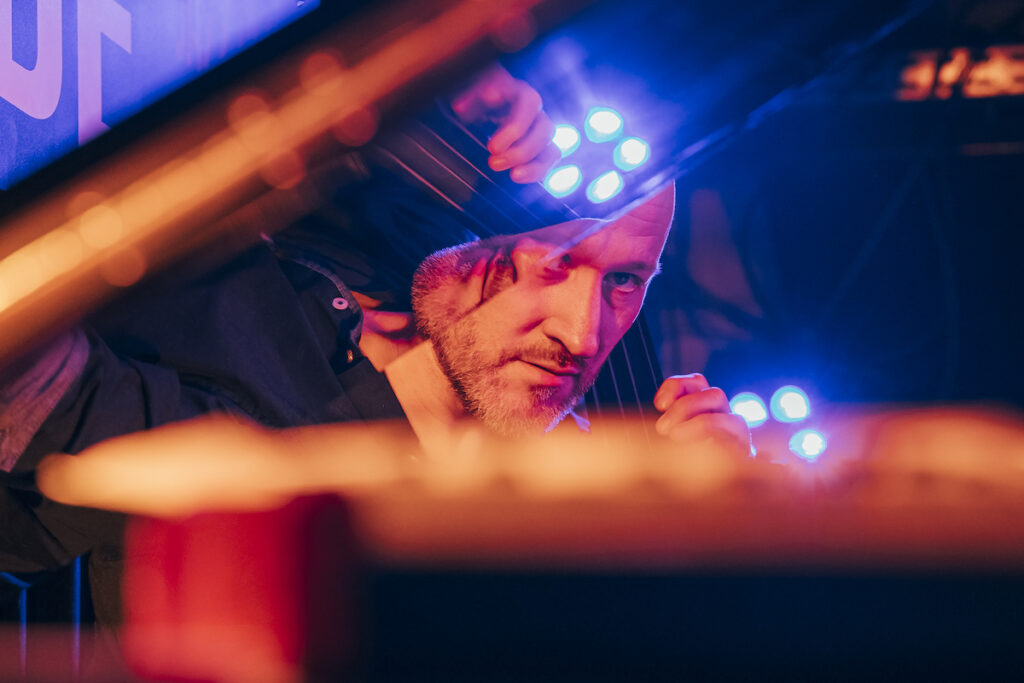
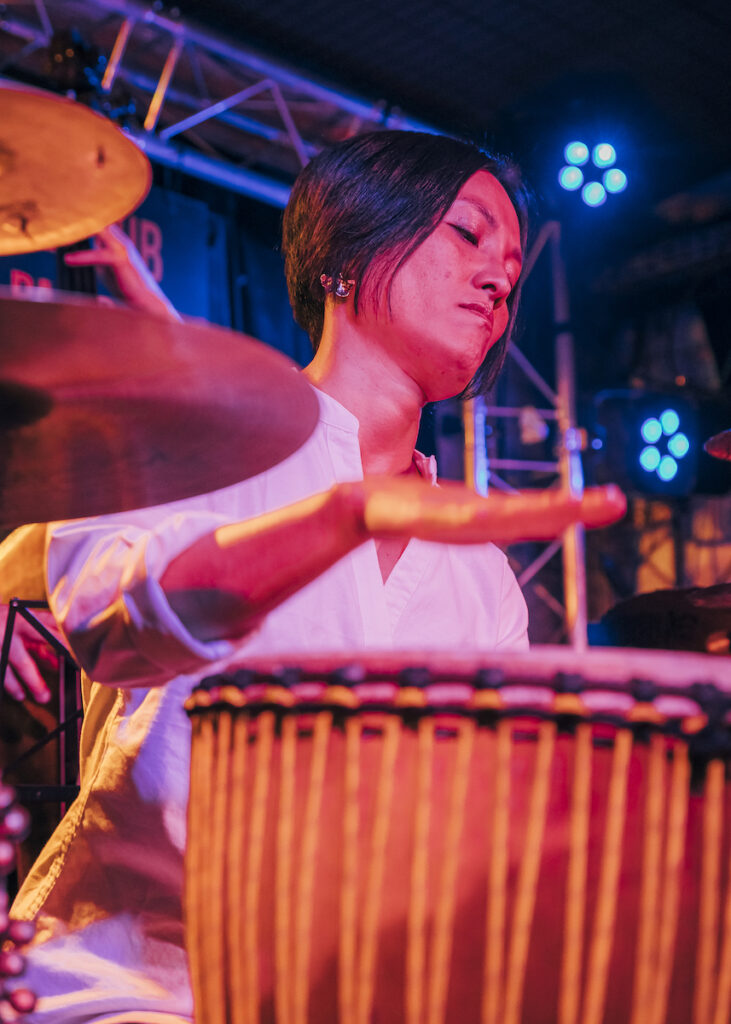
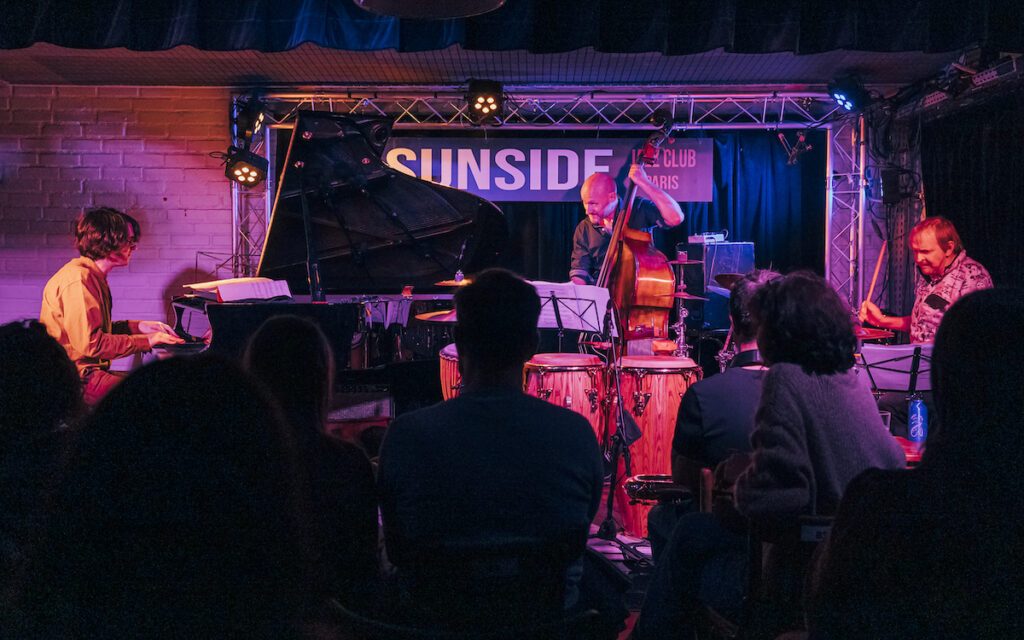
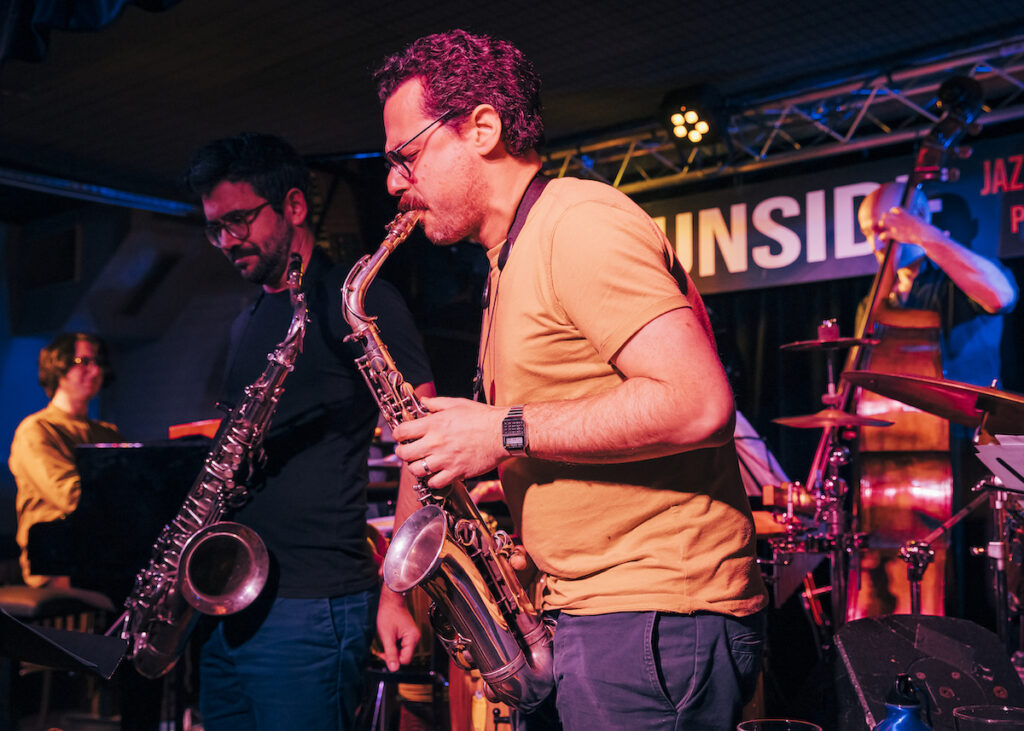


“Asteroid B612″¹ is, for the most part, a modal composition built around a two-bar ostinato (cf. sheet music² above). Its harmony is quite mysterious, and I have in fact been trying to wrap my mind around it for years³. There is indeed a sense of two distinct, overlapping tonics: the F (on every downbeat in the piano’s left hand) against the prominent Bb in the bass line. I chose to write the composition in the key of F minor, because the Db (minor sixth, implying F natural minor/Aeolian) appears often. But the note D (the major sixth, which would transform the F minor scale into an F Dorian mode) is also present (see end of measures 1 and 3). The D’s appearance alongside the Db gives the pattern a bluesy feel, and thus hints at the fact that Bb is probably the right choice for a stable tonic here (because Bb sits a minor third below Db and a major third below D, and the ambiguity of the minor/major third is characteristic of blues harmony).
Assuming that Bb is indeed our tonic leaves us with two options: Bb Dorian (equivalent to F natural minor/Aeolian) or Bb Mixolydian (equivalent to F Dorian).
Let’s summarize these findings in a simple table:
| F natural minor/Aeolian <=> Bb Dorian | Bb C Db Eb F G Ab Bb |
| F Dorian <=> Bb Mixolydian | Bb C D Eb F G Ab Bb |
Looking at the totality of the pitches present in the ostinato (cf. the sheet music at the top of this post), we have the following notes in chronological order of appearance (reading from bottom to top, i.e. bass first, then piano left hand, and finally right hand):
| Bb | F | Eb | G | C | Db | Ab | D |
All we really need to look at here is measure 1 in order to get these eight pitches. The same result can also simply be obtained by combining the pitches from the Bb Dorian and Bb Mixolydian modes: Bb C [ Db + D ] Eb F G Ab. Now, by shifting our tonic from Bb to Eb, we can rearrange these pitches into an Eb bebop dominant scale:
| Eb | D | Db | C | Bb | Ab | G | F | (Eb) |
| Eb | Db | Bb | G | (Eb) | ||||
| D | C | Ab | F |
Notice that by playing and skipping every other note, descending from the high Eb, the Eb7 chord is formed (Eb D Db C Bb Ab G F, chord tones 1, 3, 5, b7 in bold). Alternatively, playing/skipping every other note descending from the note D as your starting pitch will yield a Bb7 rootless voicing (D Db C Bb Ab G F Eb, chord tones 3, 5, b7 and tension 9). These are the I and IV chords characteristic of blues harmony.
The group of eight pitches presented in Table 2 can also be seen as two distinct Lydian scales: Db Lydian (Db Eb F G Ab Bb C) and Ab Lydian (Ab Bb C D Eb F G). Just like George Russell in his Lydian Chromatic Concept of Tonal Organization, let’s reorganize our pitches as perfect fifths stacked on top of each other:
| Db | Ab | Eb | Bb | F | C | G | |
| Ab | Eb | Bb | F | C | G | D |
From these Lydian scales, the following four major pentatonics can be derived: Db, Ab, Eb, and Bb.
| Db | Ab | Eb | Bb | F | |||
| Ab | Eb | Bb | F | C | |||
| Eb | Bb | F | C | G | |||
| Bb | F | C | G | D |
As you can see above (Tables 4 and 5), the Db and D pitches, the ones responsible for the bluesy harmonic tension we’ve been discussing all along, are at the extremities of the ladder of fifths. The remaining six “stable” pitches in between form an almost complete (without any kind of third) Bb13sus4 sound (chord tones 1, 4, 5, b7 and tensions 9, 13).
Finally, two more anhemitonic (not containing any semitones) five-note scales can be derived from the seven-note Lydian parents outlined in Table 4: the Eb and Bb dominant pentatonic scales (Eb F G Bb Db and Bb C D F Ab respectively).
| Db | Eb | Bb | F | G | |||
| Ab | Bb | F | C | D |
To me, these sound like they have an angular quality characteristic of pentatonics on the one hand (due to their intervallic content featuring major seconds and minor thirds), as well as a tertial flavour on the other. Indeed, when reordering the pitches in ladders of thirds, we fall back on our Eb and Bb dominant chords with ninths (Eb G Bb Db F and Bb D F Ab C), the very same chords we derived from the bebop dominant scale earlier (Table 3)…
Notes
¹ Recorded with Tomoko Omura (violin), Chris Jennings (double bass), and Akiko Horii (percussion) on New Dream, an album I published in late 2024.
² The sheet music presented here is an excerpt reflecting the composition’s main groove/ostinato. Full sheet music (including individual parts for violin, piano, and bass) for “Asteroid B612” is available here at Sheet Music Plus.
³ The main idea for Asteroid probably dates back to the 1990s… In fact, the tune’s ostinato and main theme are representative of some of my earliest attempts at jazz composition!
References
Funnell, Jim. New Dream. Funnelljazz FNLJZ 4. 2024.
Russell, George. Lydian Chromatic Concept of Tonal Organization – Volume One: The Art and Science of Tonal Gravity. Brookline: Concept Publishing Company, 2001.
New Dream n’usurpe pas son titre : avant de partir vers de nouveaux rêves, Funnell dresse un état des lieux de son art, entre be-bop, latin jazz et jazz contemporain, parfumé de funk et de blues, ou de touches extrêmes-orientales…
Bob Hatteau, Jazz à babord
La musique est percutante, dynamique mais jamais brutale.
Guillaume Lagrée, Le jars jase jazz
À consommer sans modération.
Un album métissé, bien agréable et remarquablement joué !
Martine Omiécinski, La Gazette Bleue
Un voyage ancré dans une quête de sincérité artistique.
Jean-Luc, Mazik
Un album vibrant, où le plaisir du jeu transpire à chaque instant la créativité en temps réel.
Patrick Dallongeville, Paris Move
Jim Funnell (piano, keyboards, melodica), Chris Jennings (double bass), Jeff Boudreaux (drums), Akiko Horii (percussion), Tomoko Omura (violin), Nino Wenger (alto saxophone)
Un álbum a tener en cuenta, rico en matices y estilos.
José Ramón, La Habitación del Jazz
🇬🇧 Epitomising the chapter of Jim’s life spent in New York City between 2016 and 2020, New Dream represents a transformation of ideals: initially setting out to break into one of the world’s foremost jazz scenes, Jim’s focus gradually shifted towards refining and delivering his own message. Recorded in Paris in 2023-2024, the album features guest artists Tomoko Omura and Nino Wenger (whom Jim (re)connected with during his time in New York), as well as, at its core, Canadian bassist Chris Jennings, drummer Jeff Boudreaux (from New Orleans), and French-Japanese percussionist Akiko Horii.
🇫🇷 Illustrant un chapitre de vie passé à New York entre 2016 et 2020, New Dream témoigne d’une transformation intérieure sur le plan des idéaux : initialement désireux de percer sur l’une des grandes places internationales du jazz, Jim s’est progressivement recentré sur l’affinement et la transmission d’un message qui lui est propre. Enregistré à Paris en 2023-2024, l’album fait appel aux artistes invités Tomoko Omura et Nino Wenger (avec lesquels Jim a (re)noué des liens pendant son séjour à New York), et accueille, en son cœur, le bassiste canadien Chris Jennings, le batteur Jeff Boudreaux (originaire de la Nouvelle-Orléans) ainsi que la percussionniste franco-japonaise Akiko Horii.
Remember that wherever your heart is, there you will find your treasure.
Paulo Coelho, The Alchemist
Jim Funnell (piano), Chris Jennings (double bass), Jeff Boudreaux (drums), Akiko Horii (percussion)
🇬🇧 An unusual blues with a funky New Orleans groove, Greenpoint Graffiti feels like walking through the gritty, sunstruck, streets of Queens and Brooklyn. A stroll Jim used to take monthly to visit his landlord’s cab business. There, he would spend all of his hard-earned cash on rent! That, too, is part of living the dream…
🇫🇷 Un blues inhabituel au groove funky dans un style néo-orléanais, Greenpoint Graffiti donne l’impression de se promener dans les rues grinçantes et ensoleillées du Queens et de Brooklyn. Une balade à laquelle Jim avait l’habitude de se livrer chaque mois pour se rendre dans les locaux de l’entreprise de taxis de sa propriétaire. Une fois sur place, il y dépensait tout le fruit de son dur labeur en loyer ! C’est cela aussi, vivre son rêve…
🇪🇸 Un blues inusual con un groove funky de estilo neo-orleano, Greenpoint Graffiti te hace sentir como si estuvieras paseando por las crujientes calles bañadas por el sol de Queens y Brooklyn. Es un paseo que Jim solía dar todos los meses de camino al negocio de taxis de su casera. Una vez allí, se gastaba todo su trabajo en el alquiler. Eso también es vivir el sueño…
🇯🇵 ニューオーリンズ・スタイルのファンキーなグルーヴを持つ一風変わったブルース、グリーンポイント・グラフィティは、まるでクイーンズやブルックリンの陽光降り注ぐ小汚い通りを散歩しているような気分にさせてくれる。
ジムが毎月大屋さんのタクシー会社まで通っていたこの散歩道。
そして一旦そこに着くと、苦労のすべてを家賃に費やした!
それが夢を生きるということだ。。。
Assuming that the left hand is going to be the weaker hand for most pianists, here are a few tips designed to help you work your way to becoming (closer to) ambidextrous at the piano…
Practicing contrapuntal music
When it comes to putting the left hand on a par with the right, melodically and technically, what better place to start than the music of Johann Sebastian Bach? His Two-Part Inventions are especially well suited for this very kind of practice, each of them being a short contrapuntal piece in a particular key, wherein the left and right hands dialogue elegantly and flawlessly.
Once a few (at the very least) of these Two-Part Inventions have been mastered, why not try out a Sinfonia (Three-Part Invention)? Adding an extra layer of counterpoint that wanders between the inner parts of the left and right hands is indeed a rewarding challenge! And for the bravest and most disciplined among us pianists, there is always the option to tackle a Prelude and Fugue from Bach’s Well-Tempered Clavier… Or, perhaps a more exotic choice, one of the twenty-four composed by Soviet-Russian composer Dmitri Shostakovich.
Playing bebop lines in octaves
This type of practice is quite straightforward: along with the blues, bebop is indeed a foundational style for every aspiring jazz pianist. It’s always best to learn the tunes by ear whenever possible. Otherwise, the Charlie Parker Omnibook provides some excellent transcriptions. Pick a tune and practice the head/solo slowly in the right hand then the left, with a click track beating on two and four. Make sure to exaggerate the swing feel (ternary subdivision of the beat and accented upbeats) throughout. Once you’re comfortable playing the lines in each hand separately, go for a more powerful sound/texture and play them both together, one or two octaves apart.
Switching roles between the left and right hands in improvisation
Typically, when it comes to jazz piano, it’s fair to say that melodic lines tend to be played in the right hand, accompanied by chords (2-, 3-, or 4-note voicings) in the left. However, turning this familiar situation around (i.e. reversing the parts played by each hand) on a regular basis when practicing/performing proves to be highly beneficial: a strong left hand is an important feature, adding variety of range and texture. Incorporating this technique into your palette will have the following effects:
References
Bach, Johann Sebastian. Inventions and Sinfonias BWV 772-801 (Two- and Three-Part Inventions).
Bach, Johann Sebastian. Das Wohltemperierte Klavier Teil I BWV 846-869. Munich: G. Henle Verlag.
Funnell, Jim. New Dream. Funnelljazz FNLJZ 4. 2024.
Parker, Charlie. Charlie Parker Omnibook: for C instruments (Treble Clef), transcribed by Jamey Aebersold and Ken Slone. Los Angeles: Alfred Music Publishing.
Shostakovich, Dmitri. 24 Preludes and Fugues, Op. 87.



Jim Funnell (piano), Chris Jennings (double bass), Jeff Boudreaux (drums)
🇬🇧 This playful, corky composition is a musical depiction of the large-scale patterns known as “crop circles,” sometimes mysteriously created in fields by flattening cereal crops… Surely, the phenomenon will boggle your mind and the tune make your ears crackle!
🇫🇷 Cette composition enjouée et percutante est une représentation musicale des motifs de grande envergure connus sous le nom de “crop circles” (cercles dans les blés), parfois mystérieusement créés dans les champs en aplatissant les cultures céréalières… Crépitement des yeux et des oreilles garanti !
🇪🇸 Esta composición alegre y contundente es una representación musical de los dibujos a gran escala conocidos como “crop circles” (círculos de las cosechas), a veces creados misteriosamente en los campos al aplastar los cultivos de cereales… Seguro que le hará saltar los ojos y los oídos.
🇯🇵 このアップビートでハードな曲は、穀類を平らにして畑に作る大規模な模様、「ミステリー・サークル」を音楽で表現したものです。目も耳もパチパチと弾むでしょう!
The mixo b2 b6 bebop dominant scale (here used as an E7(b9b13) chordmode):
| scale degrees | 1 b2 3 4 5 b6 b7 7 8 |
| chordmode | E F G# A B C D D# E |
The mixo #2 #4 bebop dominant scale (here used as an F7(#9#11) chordmode):
| scale degrees | 1 #2 3 #4 5 6 b7 7 8 |
| chordmode | F G# A B C D Eb E F |
Although the mixo b2 b6 and mixo #2 #4 bebop dominant scales laid out in the tables above have different starting pitches, they are made up of the exact same notes (in other words, they can be viewed as modes of each other).
In both cases, the added chromatic passing tone corresponds to the major seventh (7) scale degree (as is the case in several of the more “traditional” bebop scales such as the bebop dominant scale, the bebop harmonic minor scale, and the seventh flat 5 diminished scale listed on this Wikipedia page).
Further, the notes they are made up of are the chord tones belonging to two separate dominant chords, whose roots sit a semitone apart (E7 (E G# B D) and F7 (F A C Eb) in our examples). Labeling either of these scales bebop double dominant hence seems quite fitting.
It can be noted that besides the mixolydian b2 b6 (1 b2 3 4 5 b6 b7 8 / E F G# A B C D E) and mixolydian #2 #4 (1 #2 3 #4 5 6 b7 8 / F G# A B C D Eb F) modes, several other 7-note scales are contained within the 8-note bebop double dominant scale presented above: